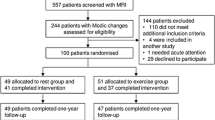Abstract
Background
There is evidence for an association between Modic type 1 and pain in patients with low back pain (LBP), but little knowledge about its effect on clinical outcomes.
Purpose
(1) To assess the prevalence of Modic changes, (2) to determine if Modic changes influence the clinical course of LBP, and (3) to identify prognostic factors for recovery.
Study design/setting
Prospective clinical cohort study, with a 1-year follow-up. The treatment consisted of brief intervention and instruction in stretching.
Patient’s sample
Two hundred and sixty-nine patients with chronic low back pain.
Outcome measures
Socio-demographic variables, education, profession, self-reported measures, degenerative changes on MRI.
Methods
Linear growth model and Cox regression analysis.
Results
Five percent had a normal MRI, 14 and 50% had Modic 1 and Modic 2 changes. Modic changes were not significant covariates for the clinical course of pain, function or fear avoidance beliefs. Education was a strong prognostic factor for recovery.
Conclusions
Modic changes did not influence the clinical course of back pain and were not prognostic factors for recovery. Education was strongly associated with recovery.

Similar content being viewed by others
References
Airaksinen O, Brox JI, Cedraschi C, Hildebrandt J, Klaber-Moffett J, Kovacs F, Mannion AF, Reis S, Staal JB, Ursin H, Zanoli G (2006) Chapter 4. European guidelines for the management of chronic nonspecific low back pain. Eur Spine J 15(Suppl 2):S192–S300
Waddell G (1987) 1987 Volvo award in clinical sciences. A new clinical model for the treatment of low-back pain. Spine 12(7):632–644
Sheehan NJ (2010) Magnetic resonance imaging for low back pain: indications and limitations. Ann Rheum Dis 69(1):7–11
Jensen TS, Karppinen J, Sorensen JS, Niinimaki J, Leboeuf-Yde C (2008) Vertebral endplate signal changes (Modic change): a systematic literature review of prevalence and association with non-specific low back pain. Eur Spine J 17(11):1407–1422
Burke JG, Watson RW, McCormack D, Dowling FE, Walsh MG, Fitzpatrick JM (2002) Intervertebral discs which cause low back pain secrete high levels of proinflammatory mediators. J Bone Joint Surg Br 84(2):196–201
Schmid G, Witteler A, Willburger R, Kuhnen C, Jergas M, Koester O (2004) Lumbar disk herniation: correlation of histologic findings with marrow signal intensity changes in vertebral endplates at MR imaging. Radiology 231(2):352–358
Modic MT, Steinberg PM, Ross JS, Masaryk TJ, Carter JR (1988) Degenerative disk disease: assessment of changes in vertebral body marrow with MR imaging. Radiology 166(1 Pt 1):193–199
Holtermann A, Hansen JV, Burr H, Sogaard K (2010) Prognostic factors for long-term sickness absence among employees with neck-shoulder and low-back pain. Scand J Work Environ Health 36(1):34–41
Carrino JA, Lurie JD, Tosteson AN, Tosteson TD, Carragee EJ, Kaiser J, Grove MR, Blood E, Pearson LH, Weinstein JN, Herzog R (2009) Lumbar spine: reliability of MR imaging findings. Radiology 250(1):161–170. doi:10.1148/radiol.2493071999
Revised International Standard Classification of Occupations: (ISCO-88) (1987) [S.I]: International Labour Office, Bureau of Statistics
Farrar JT, Pritchett YL, Robinson M, Prakash A, Chappell A (2010) The clinical importance of changes in the 0 to 10 numeric rating scale for worst, least, and average pain intensity: analyses of data from clinical trials of duloxetine in pain disorders. J Pain 11(2):109–118
Roland M, Fairbank J (2000) The Roland-Morris disability questionnaire and the Oswestry disability questionnaire. Spine 25(24):3115–3124
Grotle M, Brox JI, Vollestad NK (2006) Reliability, validity and responsiveness of the fear-avoidance beliefs questionnaire: methodological aspects of the Norwegian version. J Rehabil Med 38(6):346–353. doi:10.1080/16501970600722403
Eriksen HR, Ihlebaek C, Ursin H (1999) A scoring system for subjective health complaints (SHC). Scand J Public Health 27(1):63–72
West B, Welch K, Galecki A (2006) Linear mixed models: a practical guide using statistical software. Chapman Hall/CRC Press, London
Rothman K, Greenland S, Lash T (2008) Modern epidemiology, 1st edn. Lippincott Williams & Wilkins, Boston
Hayden JA, Dunn KM, van der Windt DA, Shaw WS (2010) What is the prognosis of back pain? Best Pract Res Clin Rheumatol 24(2):167–179
Chibnall JT, Tait RC (2009) Long-term adjustment to work-related low back pain: associations with socio-demographics, claim processes, and post-settlement adjustment. Pain Med 10(8):1378–1388
Modic MT, Ross JS (2007) Lumbar degenerative disk disease. Radiology 245(1):43–61
Kuisma M, Karppinen J, Niinimaki J, Kurunlahti M, Haapea M, Vanharanta H, Tervonen O (2006) A three-year follow-up of lumbar spine endplate (Modic) changes. Spine 31(15):1714–1718
Beresford ZM, Kendall RW, Willick SE (2010) Lumbar facet syndromes. Curr Sports Med Rep 9(1):50–56
Health literacy and the Millennium (2010) Development goals: United Nations Economic and Social Council (ECOSOC) regional meeting background paper (abstracted). J Health Commun 15(Suppl 2):211–223. doi:10.1080/10810730.2010.499996
Services USDoHaH (2000) Healthy people 2010, understanding and improving health. Washington, DC, US Government Printing Office
Altman DG, Lyman GH (1998) Methodological challenges in the evaluation of prognostic factors in breast cancer. Breast Cancer Res Treat 52(1–3):289–303
Guyatt G, Jaeschke R, Heddle N, Cook D, Shannon H, Walter S (1995) Basic statistics for clinicians: 2. Interpreting study results: confidence intervals. CMAJ 152(2):169–173
Maughan EF, Lewis JS (2010) Outcome measures in chronic low back pain. Eur Spine J 19(9):1484–1494. doi:10.1007/s00586-010-1353-6
Acknowledgments
The authors wish to acknowledge Dr. Sophie Soklaridis, Research Manager, Department of Surgery, Li Ka Shing Knowledge Institute, St. Michael’s Hospital, Toronto, Ontario, Canada for constructive criticism during preparation of this manuscript. We also acknowledge the assistance of Marianne Landa, MRI-technologist, Section of Neuroradiology, Oslo University Hospital, Ullevaal Oslo, Norway.
Conflict of interest
None.
Author information
Authors and Affiliations
Corresponding author
Rights and permissions
About this article
Cite this article
Keller, A., Boyle, E., Skog, T.A. et al. Are Modic changes prognostic for recovery in a cohort of patients with non-specific low back pain?. Eur Spine J 21, 418–424 (2012). https://doi.org/10.1007/s00586-011-1964-6
Received:
Revised:
Accepted:
Published:
Issue Date:
DOI: https://doi.org/10.1007/s00586-011-1964-6




